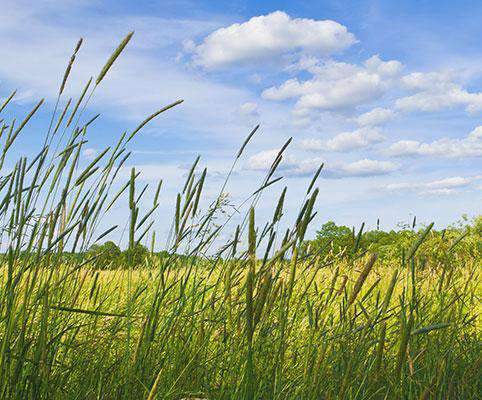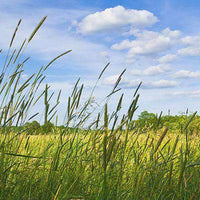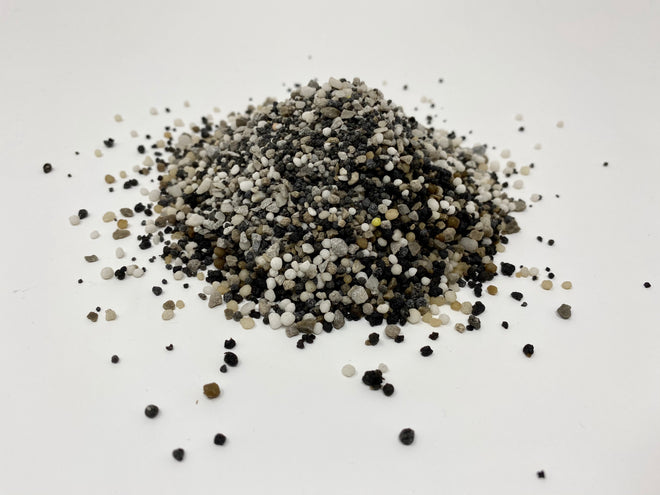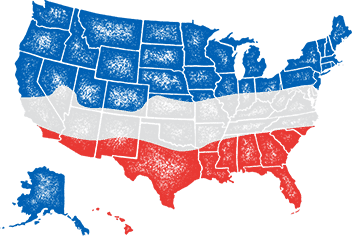
- When to plant:
- Spring, Summer
- Fertilizer:
- Hancock's 16-04-08 Lawn & Pasture Fertilizer
- Seeding rate:
- 15 lbs. per acre
- Overseeding rate:
- 10 lbs. per acre
- Seeding depth:
- 1/4 - 1/2 inch
- Ideal ph:
- 6.5 - 7.0
- Gmo:
- No
- Inoculant needed:
- No
- Coated or raw:
- Raw
- Lifecycle:
- Perennial
- Climate zones:
- Cool Season
Timothy Grass is a perennial bunchgrass with shallow and fibrous roots, used for pasture, hay production and forage for horses, cattle and livestock. Timothy Grass is best adapted to northern (cold), cooler climates and may be planted with Clovers, Alfalfa and other legumes, for food plots for deer and other wildlife. Timothy Grass performs well in more moist areas, and is very tolerant to acidity.
Product Information
- Application or Use: Pasture, Cattle Grazing, Livestock Forage, Hay Production, Cover Crop, Erosion Control, Silage
- Germination Time: 7 - 14 days, under optimal conditions
- Growing Locations: Cool Season
- Height: 2 - 4 feet
- Sunlight Requirements: 6+ hour
- Advantages: Best adapted to cool, humid climates; bunch-growth habits make this variety less competitive for nutrients.
- When to Plant: Recommended planting time is fall and spring and when night time temperatures are consistently 65 degrees and below.
Product Detail
- Perennial cool-season grass
- Best adapted to cool, humid climates
- Performs well in more moist areas
- Very tolerant to acidity
- Well suited for hay production
Product Information
Timothy Grass is well suited for use in pastures, rotational grazing, hay, conservation, erosion control and silage in the northeastern and north central climates in the United States. Varieties including Climax and Claire are common for pastures and affordable for seeding.
Timothy does not tolerate drought, salt, shade or alkalinity. It is well suited for hay production. Because of its bunch-growth habit, it is less competitive for nutrients when grown in mixtures with legumes. Spring growth is not too early although yield and palatability are very high. Main growth occurs in early Summer. It is not tolerant of close, continuous grazing. The tall shoots are easily overgrazed and as a pasture plant it is relatively short lived.
Timothy (Phleum pratense) is a perennial cool-season grass, relatively late-flowering, best adapted to cool, humid climates. At a given location, heading and blooming dates for improved cultivars may vary by as much as 7 to 10 days. Timothy normally matures 2 to 3 weeks later than Tall Fescue, Orchardgrass, and smooth Bromegrass. This feature makes it an ideal grass for late-spring grazing, or for hay harvesting since the climate is more favorable for field curing.
Timothy is very palatable, and consequently it is often selectively grazed and soon disappears when seeded with less palatable species. At certain stages of development, Timothy is intolerant of intensive grazing for reasons explained below.
Timothy is of medium height. However, in isolation, the flowering culm may reach 80-90 cm in length. During the spring season, as shoots advance toward maturity, the lowest stem internodes become enlarged and form a storage organ called a "haplocorm." The haplocorm is usually comprised of two shortened stem internodes, which gradually enlarge concurrently with the build up of food reserves. By the late boot to early-heading stage, adventitious buds in the haplocorm give rise to a new cycle of tillers. This regrowth is commonly called aftermath. In some literature it is called rowen.
The seedhead is a compact panicle in which single-floreted spikelets are supported by very short panicle branches. These diminutive branches closely resemble short pedicels found on some raceme inflorescences. The timothy panicle is so compact that is sometimes confused as a spike.
*Product packaging may appear different than what is pictured.
Plant between September and November at a rate of 10 to 15 lbs. per acre. Plant at a depth of 1/4 to 1/2 in.
As with most grass, the overwintering tillers resume growth when the climate is favorable. With advancing maturity, individual shoots exhibit growth stages. They include tillering, transition from vegetative to reproduction (late boot, early heading of seedhead, and flowering). These developmental stages need to be recognized when making management decisions.
The tillering stage represents the initial Spring growth. The main growing point (apical meristem) of the shoot is in a vegetative stage, producing new leaves. After a suitable period of development, this growing point is gradually transformed into a floral bud that soon produces a rudimentary seedhead. The shoot has entered the transition stage of development. Thereafter, leaf formation ceases and the leaf number is fixed.
The transition stage can be identified by splitting a shoot with a sharp blade in order to inspect the growing point. By this time the lowermost basal internode of the developing culm has commenced elongation, possibly raising the rudimentary seedhead together with the underlying meristematic zone to a grazing height. This vitally important meristematic zone contains cells which account for the central stalk (culm), as well as cells which account for the leaves. This zone represents the preferred regrowth mechanism if haplocorm buds have yet formed new tiller initials.
It is self-evident that Timothy, as well as many other grasses, should be carefully managed during early transition. If a high percentage of the shoots are in this developmental stage, it is wise to avoid wholesale destruction of this shoot zone, as might occur under "management intensive grazing" (MIG). Lenient grazing is advised until such time as haplocorm buds are capable of producing prompt competitive regrowth.
The appearance of new shoots indicates that food reserves have been restored and that a new regrowth mechanism is ready to function. New shoots also signal the time to initiate intensive grazing and for storing the forage from ungrazed pastures.
Under-grazed pastures should be clipped at early-heading with a high blade setting so as to minimize destruction of vegetative shoots. Livestock relish the clippings at this stage of maturity. Additionally, it is wise to prevent seedhead development because plant hormones associated with flowering temporarily suppress new tiller growth. Destruction of seedheads promotes earlier aftermath growth ensuring development of new roots prior to the advent of arid conditions.
Given approximately five weeks deferment from further defoliation, aftermath shoots start culm development. Stem internodes in the base of the shoot commence to elongate, elevating the meristematic growing point to a grazing height. The growing point may exhibit a developing seedhead, thus the leaf number is again fixed. If it remains vegetative, leaf number is indeterminant. As previously described, for the initial growth, the aftermath has reached the transition stage of development.
Prior to internode elongation, the aftermath can be grazed with minimal risk provided sufficient leaf blade tissue remains in the stubble. Photosynthesis in the leaf blade canopy largely negates the need for stored food reserves. However, when internodes start to elongate, the meristematic growing point may be destroyed. When this occurs, the vigor of subsequent regrowth varies with the readiness of haplocorm to produce another cycle of tillers. If the bud-bearing region is not active, or if a new root system is not yet well established, the grass either goes dormant or perishes.
Leaf blades are rolled (as opposed to folded) in the shoot whorl. A prominent membranous ligule arises from the collar zone at the base of the blade. Early Spring growth is comprised chiefly of leaf blades because sheath elongation commences only after the blade is well formed. This growth habit provides a measure of grazing tolerance because the meristematic collar zone of most of the leaves is nested safely below the grazing height. Immature leaves severed above the collar continue development due to cell division, and expansion in the intercalary meristem located in the collar region.
Frequent moderate defoliation, as practiced in turf management, tends to suppress sheath elongation. This may provide a measure of flexibility in grazing management, however, it does not favor deep rooting or restoration of food reserves necessary for winter hardiness.
When choosing to start a new lawn, remove old vegetation by using a de-thatcher, power rake or tiller to kill the existing vegetation. Rake or drag the area to remove debris and dead grass for a clean area. Ensure the soil is leveled and loosened to allow the seed to have good soil contact once spread on a clean seed bed.
If you have an area with heavy weed coverage, we recommend starting fresh by killing and removing the existing vegetation. If you choose to use chemicals, herbicides or fertilizers, you must check with the product's manufacturer prior to planting new seed to ensure the proper waiting period.
When overseeding an existing area, mow your lawn at the lowest setting and bag the clippingsx. Rake or drag any areas that have dead thatch or debris.

Seed Quality
Hancock Seed is dedicated to delivering the best seeds possible to our customers. Hancock Seed grows and harvests many of our products, and we acquire the majority of the rest from other family farmers.
All these seeds are processed, packaged and shipped from Hancock Farm. This helps us ensure that our high standards are met. Unlike much of the competition, we refuse to sell you a seed that was not gathered during the last harvest. You will always receive fresh product from Hancock.
Every seed we grow comes with 40 years of experience behind it...you can rest assured that all of our products are cultivated in a method that assures its potential for growth.
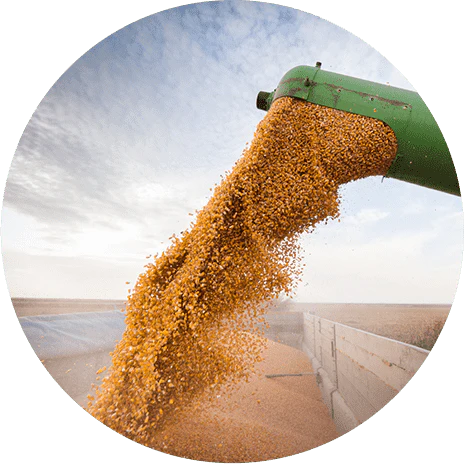
Your cart ( 0 )

Timothy Grass is a perennial bunchgrass with shallow and fibrous roots, used for pasture, hay production and forage for horses, cattle and livestock. Timothy Grass is best adapted to northern (cold), cooler climates and may be planted with Clovers, Alfalfa and other legumes, for food plots for deer and other wildlife. Timothy Grass performs well in more moist areas, and is very tolerant to acidity.
Product Information
- Application or Use: Pasture, Cattle Grazing, Livestock Forage, Hay Production, Cover Crop, Erosion Control, Silage
- Germination Time: 7 - 14 days, under optimal conditions
- Growing Locations: Cool Season
- Height: 2 - 4 feet
- Sunlight Requirements: 6+ hour
- Advantages: Best adapted to cool, humid climates; bunch-growth habits make this variety less competitive for nutrients.
- When to Plant: Recommended planting time is fall and spring and when night time temperatures are consistently 65 degrees and below.
Product Detail
- Perennial cool-season grass
- Best adapted to cool, humid climates
- Performs well in more moist areas
- Very tolerant to acidity
- Well suited for hay production
Product Information
Timothy Grass is well suited for use in pastures, rotational grazing, hay, conservation, erosion control and silage in the northeastern and north central climates in the United States. Varieties including Climax and Claire are common for pastures and affordable for seeding.
Timothy does not tolerate drought, salt, shade or alkalinity. It is well suited for hay production. Because of its bunch-growth habit, it is less competitive for nutrients when grown in mixtures with legumes. Spring growth is not too early although yield and palatability are very high. Main growth occurs in early Summer. It is not tolerant of close, continuous grazing. The tall shoots are easily overgrazed and as a pasture plant it is relatively short lived.
Timothy (Phleum pratense) is a perennial cool-season grass, relatively late-flowering, best adapted to cool, humid climates. At a given location, heading and blooming dates for improved cultivars may vary by as much as 7 to 10 days. Timothy normally matures 2 to 3 weeks later than Tall Fescue, Orchardgrass, and smooth Bromegrass. This feature makes it an ideal grass for late-spring grazing, or for hay harvesting since the climate is more favorable for field curing.
Timothy is very palatable, and consequently it is often selectively grazed and soon disappears when seeded with less palatable species. At certain stages of development, Timothy is intolerant of intensive grazing for reasons explained below.
Timothy is of medium height. However, in isolation, the flowering culm may reach 80-90 cm in length. During the spring season, as shoots advance toward maturity, the lowest stem internodes become enlarged and form a storage organ called a "haplocorm." The haplocorm is usually comprised of two shortened stem internodes, which gradually enlarge concurrently with the build up of food reserves. By the late boot to early-heading stage, adventitious buds in the haplocorm give rise to a new cycle of tillers. This regrowth is commonly called aftermath. In some literature it is called rowen.
The seedhead is a compact panicle in which single-floreted spikelets are supported by very short panicle branches. These diminutive branches closely resemble short pedicels found on some raceme inflorescences. The timothy panicle is so compact that is sometimes confused as a spike.
*Product packaging may appear different than what is pictured.
Plant between September and November at a rate of 10 to 15 lbs. per acre. Plant at a depth of 1/4 to 1/2 in.
As with most grass, the overwintering tillers resume growth when the climate is favorable. With advancing maturity, individual shoots exhibit growth stages. They include tillering, transition from vegetative to reproduction (late boot, early heading of seedhead, and flowering). These developmental stages need to be recognized when making management decisions.
The tillering stage represents the initial Spring growth. The main growing point (apical meristem) of the shoot is in a vegetative stage, producing new leaves. After a suitable period of development, this growing point is gradually transformed into a floral bud that soon produces a rudimentary seedhead. The shoot has entered the transition stage of development. Thereafter, leaf formation ceases and the leaf number is fixed.
The transition stage can be identified by splitting a shoot with a sharp blade in order to inspect the growing point. By this time the lowermost basal internode of the developing culm has commenced elongation, possibly raising the rudimentary seedhead together with the underlying meristematic zone to a grazing height. This vitally important meristematic zone contains cells which account for the central stalk (culm), as well as cells which account for the leaves. This zone represents the preferred regrowth mechanism if haplocorm buds have yet formed new tiller initials.
It is self-evident that Timothy, as well as many other grasses, should be carefully managed during early transition. If a high percentage of the shoots are in this developmental stage, it is wise to avoid wholesale destruction of this shoot zone, as might occur under "management intensive grazing" (MIG). Lenient grazing is advised until such time as haplocorm buds are capable of producing prompt competitive regrowth.
The appearance of new shoots indicates that food reserves have been restored and that a new regrowth mechanism is ready to function. New shoots also signal the time to initiate intensive grazing and for storing the forage from ungrazed pastures.
Under-grazed pastures should be clipped at early-heading with a high blade setting so as to minimize destruction of vegetative shoots. Livestock relish the clippings at this stage of maturity. Additionally, it is wise to prevent seedhead development because plant hormones associated with flowering temporarily suppress new tiller growth. Destruction of seedheads promotes earlier aftermath growth ensuring development of new roots prior to the advent of arid conditions.
Given approximately five weeks deferment from further defoliation, aftermath shoots start culm development. Stem internodes in the base of the shoot commence to elongate, elevating the meristematic growing point to a grazing height. The growing point may exhibit a developing seedhead, thus the leaf number is again fixed. If it remains vegetative, leaf number is indeterminant. As previously described, for the initial growth, the aftermath has reached the transition stage of development.
Prior to internode elongation, the aftermath can be grazed with minimal risk provided sufficient leaf blade tissue remains in the stubble. Photosynthesis in the leaf blade canopy largely negates the need for stored food reserves. However, when internodes start to elongate, the meristematic growing point may be destroyed. When this occurs, the vigor of subsequent regrowth varies with the readiness of haplocorm to produce another cycle of tillers. If the bud-bearing region is not active, or if a new root system is not yet well established, the grass either goes dormant or perishes.
Leaf blades are rolled (as opposed to folded) in the shoot whorl. A prominent membranous ligule arises from the collar zone at the base of the blade. Early Spring growth is comprised chiefly of leaf blades because sheath elongation commences only after the blade is well formed. This growth habit provides a measure of grazing tolerance because the meristematic collar zone of most of the leaves is nested safely below the grazing height. Immature leaves severed above the collar continue development due to cell division, and expansion in the intercalary meristem located in the collar region.
Frequent moderate defoliation, as practiced in turf management, tends to suppress sheath elongation. This may provide a measure of flexibility in grazing management, however, it does not favor deep rooting or restoration of food reserves necessary for winter hardiness.
Instructions
When choosing to start a new lawn, remove old vegetation by using a de-thatcher, power rake or tiller to kill the existing vegetation. Rake or drag the area to remove debris and dead grass for a clean area. Ensure the soil is leveled and loosened to allow the seed to have good soil contact once spread on a clean seed bed.
If you have an area with heavy weed coverage, we recommend starting fresh by killing and removing the existing vegetation. If you choose to use chemicals, herbicides or fertilizers, you must check with the product's manufacturer prior to planting new seed to ensure the proper waiting period.
When overseeding an existing area, mow your lawn at the lowest setting and bag the clippingsx. Rake or drag any areas that have dead thatch or debris.















